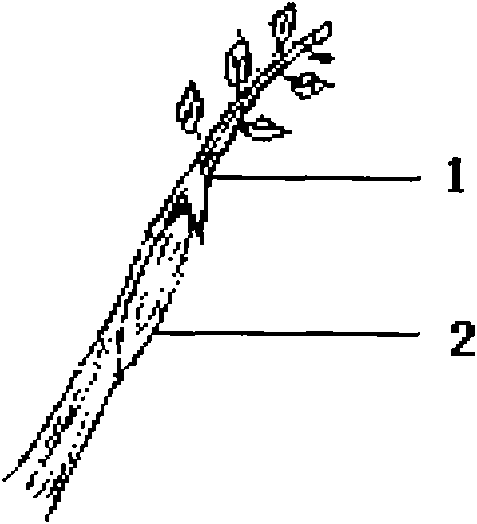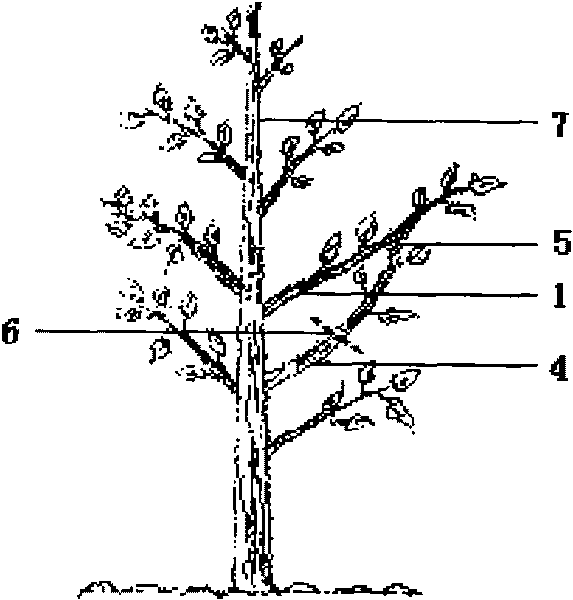Graft modeling method of branches and ears of trees
A technology for trees and rootstocks, applied to the field of grafting modeling hanging on the side branches of the rootstocks, can solve the problems of lack of aesthetics, difficult to survive, poor ornamental properties, etc., and achieves the effects of improving landscape viewing value and easy grafting healing.
- Summary
- Abstract
- Description
- Claims
- Application Information
AI Technical Summary
Problems solved by technology
Method used
Image
Examples
Embodiment 1
[0036] Ginkgo biloba (G.biloba) branches and spikes grafting
[0037] 1. Overview
[0038] There are 5 10-year-old ginkgo landscape trees, each grafted with 5 scions (scions), and a total of 25 shoots.
[0039] 2. Branch spike grafting
[0040] In late March, on the crown of each ginkgo tree, 5 branches were selected as rootstocks, and the 5 adjacent branches of the same plant were scions (branch spikes). Grafting by butt-joint method: the joint of branches and ears is cut from bottom to top, a little xylem is cut off, the front is cut into a horse ear shape with a length of about 2.0cm to 3.0cm, and the upper end of the back is cut into a 0.5cm to 0.8cm long oblique section (see figure 2 ). On the rootstock branch, cut into a longitudinal section with a depth of xylem, corresponding to the branch ear, and a length of about 2.0cm to 3.0cm (see figure 1 ). Then make the scion and the rootstock incision closely connected, and wrap it with a plastic film band without a knot...
Embodiment 2
[0046] Metasequoia (M.glyptostroboides) branches and ears grafted
[0047] 1. Overview
[0048] There are 3 8-year-old metasequoia landscape trees, each grafted with 10 branches and ears, a total of 30 branches and ears.
[0049] 2. Branch spike grafting
[0050] For each Metasequoia tree, 5 branches and spikes are grafted in the middle of the crown and 5 branches and spikes are grafted in the lower part of the crown. Grafting method step is the same as embodiment one.
[0051] 3. Cultivation management
[0052] Same as the general metasequoia tree.
[0053] In the present embodiment, 29 branches and ears were survived altogether, and the survival rate was 96.7%.
Embodiment 3
[0055] Grafting and Propagation of Kuding Tea Tree (I.latifollia)
[0056] 1. Overview
[0057] There are 20 5-year-old saplings of Kudingcha, each grafted with 5 branches and ears, and a total of 100 branches and ears.
[0058] 2. Branch spike grafting
[0059] In the first ten days of April, 15 plants and 75 spikes were grafted on the same plant; 25 spikes were grafted from adjacent different plants. Grafting method step is the same as embodiment one.
[0060]After the grafting survived, in the first ten days of October of that year, the surviving branches and ears were cut off 30 cm below the joint, and the incision should be smooth. Then wrap it with a plastic bag filled with soil (different from layering propagation) to promote callus and new roots from the incision. By the end of October of the following year, cut each surviving fringe hanging under the rootstock branch from the tip close to the joint. It is then planted in a nursery plot to grow into a new plant. ...
PUM
| Property | Measurement | Unit |
|---|---|---|
| Length | aaaaa | aaaaa |
Abstract
Description
Claims
Application Information
 Login to View More
Login to View More - R&D
- Intellectual Property
- Life Sciences
- Materials
- Tech Scout
- Unparalleled Data Quality
- Higher Quality Content
- 60% Fewer Hallucinations
Browse by: Latest US Patents, China's latest patents, Technical Efficacy Thesaurus, Application Domain, Technology Topic, Popular Technical Reports.
© 2025 PatSnap. All rights reserved.Legal|Privacy policy|Modern Slavery Act Transparency Statement|Sitemap|About US| Contact US: help@patsnap.com



